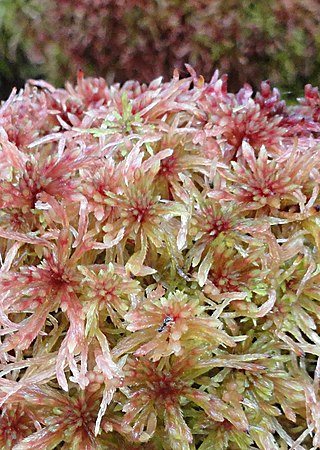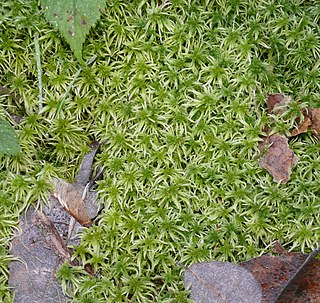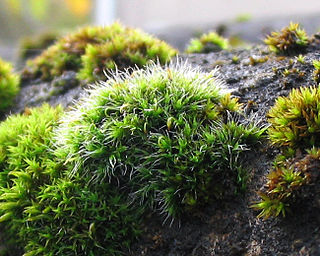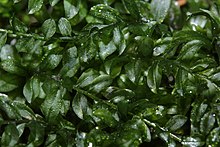Rhytidiadelphus triquetrus, the big shaggy-moss or rough goose neck moss, is a species of moss in the family Hylocomiaceae. It is often the dominating moss species in moderately rich forest habitats in the boreal regions and the Pacific Northwest. Because of its fuzzy appearance and tail-like shape it is also called the 'electrified cat's tail moss'. Not to be confused with square goose-necked moss, Rhytidiadelphus squarrosus.

Helodium blandowii, also known as Blandow's helodium moss, Blandow's tamarisk-moss, Blandow's bogmoss, and Blandow's feathermoss, is a rare plant in the Western U.S., including Oregon and California. It occurs all around the northern hemisphere in higher latitudes, and in some places is not as rare as in the Western U.S.

The flora of Scotland is an assemblage of native plant species including over 1,600 vascular plants, more than 1,500 lichens and nearly 1,000 bryophytes. The total number of vascular species is low by world standards but lichens and bryophytes are abundant and the latter form a population of global importance. Various populations of rare fern exist, although the impact of 19th-century collectors threatened the existence of several species. The flora is generally typical of the north-west European part of the Palearctic realm and prominent features of the Scottish flora include boreal Caledonian forest, heather moorland and coastal machair. In addition to the native species of vascular plants there are numerous non-native introductions, now believed to make up some 43% of the species in the country.
Pohlia scotica, commonly known as Scottish threadmoss, is a moss endemic to Scotland. The earliest records date to 1964 and this moss was recognised as a distinct species in 1982. The largest populations are in Argyll with smaller populations in Dunbartonshire and Easter Ross. Its favoured habitat is silt, sand and gravel subject to regular inundation. The species has been provisionally classified as Lower Risk and receives protection under the Wildlife and Countryside Act 1981.

Hylocomium splendens, commonly known as glittering woodmoss, splendid feather moss, stairstep moss, and mountain fern moss, is a perennial clonal moss with a widespread distribution in Northern Hemisphere boreal forests. It is commonly found in Europe, Russia, Alaska and Canada, where it is often the most abundant moss species. It also grows in the Arctic tundra and further south at higher elevations in, for example, northern California, western Sichuan, East Africa, Australia, New Zealand and the West Indies. In Scotland it is a characteristic species of the Caledonian Forest. Under the UK's national vegetation classification system, pinewood community W18 is named as "Pinus sylvestris-Hylocomium splendens woodland", indicating its significance in this ecosystem.
Marsupella arctica, commonly known as Arctic rustwort, is a species of liverwort found in the Northern Hemisphere. It is present in Alaska and Greenland and has a European distribution confined to Scotland and Svalbard. The Scottish population was first discovered in 1989 and is restricted to two sites in the Cairngorm mountains - the Lairig Ghru and Beinn a' Bhùird.
Hygrohypnum styriacum, commonly known as snow brook-moss or hygrohypnum moss is a species of moss found in the Northern Hemisphere.
Didymodon mamillosus, commonly known as Perthshire beardmoss, is a species of moss endemic to Europe. It occurs at only five sites including one in Scotland where it is classified as "Critically Endangered". The other sites are in Iceland, Germany, the Czech Republic and in north-east Spain.

Andreaea frigida, commonly known as icy rockmoss, is a moss endemic to Europe which is found in mountainous regions in Austria, the Czech Republic, France, Germany, Hungary, Italy, Norway, Romania, Poland, and Spain. In the UK its occurrence is widespread in the Cairngorms National Park, where it is typically found on rocks in burns fed by snow patches, but it is not found elsewhere except at a single site in the Lake District of England.
Tayloria lingulata, commonly known as lingulate dung moss, tongue-leaved gland-moss, or marsh collar-moss, is a moss found in montane habitats in the Northern Hemisphere including Europe, Asia and North America.

Hypnum cupressiforme, the cypress-leaved plaitmoss or hypnum moss, is a common and widespread species of moss belonging to the genus Hypnum. It is found in all continents except Antarctica and occurs in a wide variety of habitats and climatic zones. It typically grows on tree trunks, logs, walls, rocks and other surfaces. It prefers acidic environments and is fairly tolerant of pollution. It was formerly used as a filling for pillows and mattresses; the association with sleep is the origin of the genus name Hypnum.

Sphagnum russowii, Russow's sphagnum or Russow's bogmoss, is a species of peat moss with a Holarctic distribution.

Sphagnum girgensohnii, also known as Girgensohn's bogmoss, Girgensohn's sphagnum or common green peat moss, is a species of peat moss with a Holarctic and Indo-Malesian distribution.

Sphagnum palustre, the prairie sphagnum or blunt-leaved bogmoss, is a species of peat moss from the genus Sphagnum, in the family Sphagnaceae. Like other mosses of this type it can soak up water up to the 30-fold amount of its own dry weight thanks to its elastic spiral fibers. S. palustre is rather frequent and is spread almost all over the world. It mainly grows in wet forests and—compared to other specimens of this genus—rarely grows in moors.

Splachnum sphaericum, also known as pinkstink dung moss, is a species of moss. This species occurs in North America. It also occurs in upland Britain, where it is known as round-fruited collar-moss and in north temperate and boreal regions of Europe. Its habitat is bog and wet heathland where it grows on herbivore dung. This and other Splachnum species are entomophilous. The sporophytes, which are generally coloured red or black, produce an odour of carrion that is attractive to flies and the spores are dispersed by flies to fresh dung.

Calliergon cordifolium is a species of moss in the Calliergonaceae family, commonly known as the calliergon moss or heart-leaved spearmoss. The species is abundant in the right habitat, and grows in marshes and wet woodland, especially woodland of alder (Alnus) or willow (Salix), as well as around streams, ditches and pools. The species grows in tufts among other moss species. Calliergon cordifolium requires a wet environment to grow, and often grows completely submerged in water. It typically prefers lowland, but has been recorded as high as 910 metres (1,000 yd) above sea level in Inverness, Scotland. The species has a circumpolar Boreo-temperate distribution. It is found throughout Europe. It has been recorded in north and central Asia, as well as Turkey and Japan, throughout North America and in New Zealand.

Tortula acaulon, formerly Phascum cuspidatum, the cuspidate earth-moss or toothed phascum moss, is a moss with 3 mm leaves which forms green patches. It is very common and has a number of varieties in a wide range of habitats. The variety piliferum occurs on sandy soils near the sea.

Mnium stellare, the starry thyme-moss or stellar calcareous moss, is a moss species in the genus Mnium.

Leptodictyum riparium, commonly known as Kneiff's feathermoss, streamside leptodictyum moss, or knapwort, is a species of moss of cosmopolitan distribution. The only places it is not found are the Pacific Islands and Australia. It is commonly found growing in the lakes and rivers of Minnesota and is also present in Mexico, Guatemala, the Bahamas, Cuba, Jamaica, Haiti, the Dominican Republic, Venezuela, Peru and Brazil.

Grimmia pulvinata, otherwise known as grey-cushioned grimmia or pulvinate dry rock moss, is a bryophyte moss common in temperate climates worldwide.














